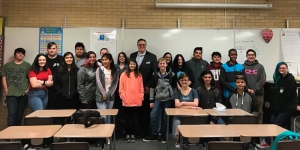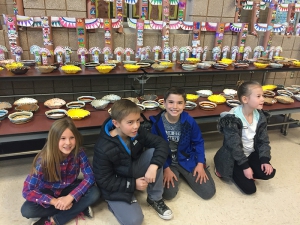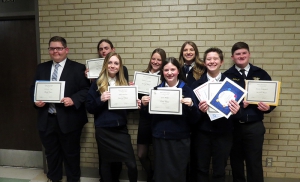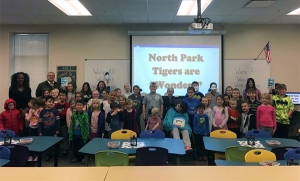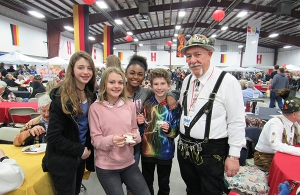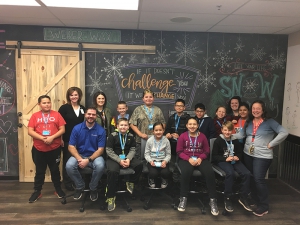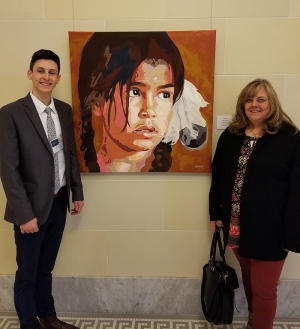Super User
Best selling Author, Sam Bracken visits T.H. Bell Junior High
Plain City Elementary Holds Literacy & Art Night
During February parent conference week, Plain City Elementary held the culminating event for its One Book One School program. Every family in the school received a copy of the classic book, "The Indian in the Cupboard." Throughout November and December, students were given bi-weekly reading goals. A drawing was held every two weeks from names of students who had met the goal, and two students from every grade level got to pick out a new book. All students participated in various challenges, such as guessing the number of tiny plastic cowboys and Indians in a giant jar, hunting for the hidden Indian, or seeing if they were one of the lucky students to have a magic key hidden under their chair. Students who completed the book by the deadline were rewarded with donuts. In art class, Mr. Hadley taught students about Native American art, and every student made at least one piece of art. They included: woven Native American mats, dream catchers, Eye of Gods, beaded and woven bowls, totem poles, buffalo skin story maps, sand art, and feather necklaces. On Art & Literacy Night, students and parents were invited to "Step Into 'The Indian in the Cupboard," to view all the fine artwork. Many students are now reading the sequel to the book, "Return of the Indian."






Students from Weber High received STEM Fair awards and are headed to the Weber State University Ritchey Fair on March 23rd.
March Superintendency Message
A message from Assistant Superintendent Kevin Sederholm:
Last year at this time, I wrote a Superintendency Message about recruiting new teachers. One year later, here we are again looking to bring new teachers to our district that will positively impact our students. We will always try and find the best candidates possible to be with our students.
Recently I was at a job fair recruiting when a young teacher approached me and said, “I want to teach in your district.” I found out that this teacher was from out of state but would be moving into our area. Out of curiosity I asked her why she wanted to teach for us. Her response was that she had researched all of the districts in our surrounding area and had talked to many people who live in the vicinity. She went on to say that although what she read about our district was impressive, it was the fact that with all the many people she had talked to about our district, no one said anything negative. This was a proud moment and I have to admit this has happened on many other occasions with myself as well as others that have helped me recruit.
I attribute this experience to the many dedicated employees and parents that we have in our district. People who go about their day knowing their most important job is to take care of children.
Weber School District has been and will always be dedicated to teaching and developing the whole child. We will continue to look for those future employees that will meet these expectations. Many thanks go out to everyone that helps with this process.
North Park recognizes all students are Wonders, with classes reading "Wonder" and activities focused on acceptance in the Library
T.H. Bell students attend the Hof Germanfest to learn about German culture!
West Haven Design Club visits the WSD Tech Shed to discuss ways to tackle chronic absenteeism
Fremont High senior selected as the first place winner of the Utah Senate Visual Arts Competition.
February 2018 Superintendency Message
Some years ago, I had the privilege of listening to the renowned historian, David McCullough, speak in Salt Lake City. The title of his lecture instantly grabbed my attention—“The Importance of Teachers.” McCullough discussed the influence teachers had had on key figures in American history. I was especially impressed by one of McCullough’s stories—The Incident of the Fish:
Louis Agassiz, a well-known American scientist of his day, was also a master teacher with a rather unconventional teaching style. Agassiz was a professor at Harvard University. He prepared no syllabus for his courses, nor did he require an entrance exam for students to enroll in his classes. They were accepted simply on whether or not he liked them, which meant that he took just about everyone.
Agassiz believed that the way to all learning, “the backbone of education,” as he frequently reminded his students, was to know something thoroughly. “A smattering of everything is worth little,” he asserted. His goal was to teach students “to see deeply” in order to develop genuine understanding. This objective was illustrated by “the incident of the fish,” as told by one of his former students, Samuel Scudder.
After Professor Agassiz interviewed and accepted Samuel Scudder into his class, he asked Samuel when he would like to begin. Scudder responded, “Right now.” Agassiz excused himself momentarily. When he re-entered the classroom, he was carrying a dead fish! This was a stinking, putrid and foul-smelling fish personally selected by Agassiz from among countless jars lining the shelves. Professor Agassiz placed the dead fish on a dish in front of Samuel Scudder. He then provided this simple instruction, “Look at the fish.” At this point, Agassiz left the room. Scudder described what happened next:
In ten minutes I had seen all that could be seen of that fish. Half an hour passed—an hour—another hour; the fish began to look loathsome. I turned it over and around; looked it in the face—ghastly! I was in despair. I was forbidden to use a magnifying glass. Instruments of all kinds were forbidden. My two hands, my two eyes, and the fish! It seemed a most limited field. I pushed my finger down its throat to feel how sharp the teeth were. I began to count the scales in the different rows, until I was convinced that that was nonsense. At last a happy thought struck me—I would draw the fish, and now with surprise I began to discover new features in the creature.
Hours later, Agassiz returned and listened as Scudder attempted to describe his observations and asked his teacher what he should do next. The astute professor repeated his original directive, “Look at the fish!” Scudder continued:
I was irritated; I was mortified. Still more of that wretched fish! But now I set myself to my task with a renewed will, and discovered one new thing after another. The afternoon passed quickly; and when, toward its close, the professor inquired, “Do you see it?” I replied, “No, I am certain I do not, but I see how little I saw before.
The following day, having thought of the fish throughout the night, Samuel Scudder had a brainstorm. “The fish,” he explained to Professor Agassiz, “had symmetrical sides with paired organs.”
“Of course! Of course!” Agassiz said, obviously delighted, when his new student shared his newfound insight. Once again, Scudder asked what he should do next, and Agassiz enthusiastically replied, “Oh, look at your fish!” This lesson went on for three full days. “Look, look, look!” was the repeated charge. Years later, Scudder, who became widely known for his work on the importance of first-hand, careful observation in the natural sciences, frequently recalled the legacy of his beloved teacher.
In an era that places too great an emphasis on testing, it is vital that we continue to teach for deep understanding, just as Louis Agassiz did so many years ago. We should always consider the following question, “What does it mean to truly understand something?” Understanding fundamental, core ideas and developing the capacity to transfer and apply should be the primary goals of all teaching and learning. Thank you to the hundreds of dedicated teachers in Weber School District who teach for deep understanding, application and transfer every day. This remains “the backbone” of a child’s educational experience.
